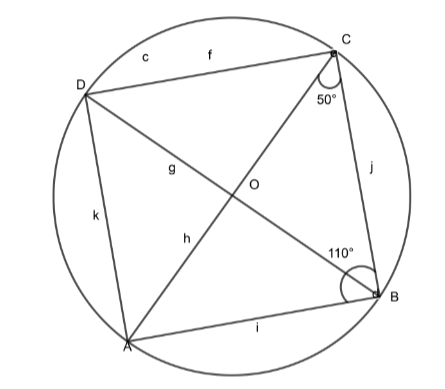
ABCD is a cyclic quadrilateral whose diagonals intersect at O. If $\angle ACB=50{}^\circ$ and $\angle ABC=110{}^\circ$, find $\angle BDC$.


Answer
606.9k+ views
Hint: We can solve this problem by using the property of angle inscribed by the arc, i. e. Angles inscribed by the same arc on the circumference of a circle are always EQUAL, and the property of a triangle.
Complete step-by-step answer:
Firstly, we will write the given values,
$\angle ACB=50{}^\circ$ and $\angle ABC=110{}^\circ $……………………………….. (1)
To find the required angle we should know the key concept which is given below,
Angles inscribed by the same arc on the circumference of a circle are always EQUAL, which means, angles made by arc BC at point D and A on the circumference of the circle are equal.
\[\therefore \angle BDC=\angle BAC\]……………………………………………….. (2)
To find the value of \[\angle BAC\] consider\[\vartriangle ABC\],
As the sum of angles of a triangle is always \[180{}^\circ \]
\[\therefore \angle ABC+\angle BAC+\angle ACB=180{}^\circ \]
Put the values of (1) in the above equation,
\[\Rightarrow 110{}^\circ +\angle BAC+50{}^\circ =180{}^\circ \]
\[\Rightarrow \angle BAC=180{}^\circ -160{}^\circ \]
\[\Rightarrow \angle BAC=20{}^\circ \]
Now put the value of equation (2) in the above equation,
\[\Rightarrow \angle BDC=\angle BAC=20{}^\circ \]
\[\therefore \angle BDC=20{}^\circ \]
Therefore the value of \[\angle BDC\] is \[20{}^\circ \].
Note: In the problem they have just mentioned that diagonals are passing through point O, but it is not clear that O is the centre of the circle. If we consider YOU as center then, \[\angle DCA\] will become \[40{}^\circ \] and we will get the final answer as \[\angle BDC=50{}^\circ \] which is a wrong answer.
Complete step-by-step answer:
Firstly, we will write the given values,
$\angle ACB=50{}^\circ$ and $\angle ABC=110{}^\circ $……………………………….. (1)
To find the required angle we should know the key concept which is given below,
Angles inscribed by the same arc on the circumference of a circle are always EQUAL, which means, angles made by arc BC at point D and A on the circumference of the circle are equal.
\[\therefore \angle BDC=\angle BAC\]……………………………………………….. (2)
To find the value of \[\angle BAC\] consider\[\vartriangle ABC\],
As the sum of angles of a triangle is always \[180{}^\circ \]
\[\therefore \angle ABC+\angle BAC+\angle ACB=180{}^\circ \]
Put the values of (1) in the above equation,
\[\Rightarrow 110{}^\circ +\angle BAC+50{}^\circ =180{}^\circ \]
\[\Rightarrow \angle BAC=180{}^\circ -160{}^\circ \]
\[\Rightarrow \angle BAC=20{}^\circ \]
Now put the value of equation (2) in the above equation,
\[\Rightarrow \angle BDC=\angle BAC=20{}^\circ \]
\[\therefore \angle BDC=20{}^\circ \]
Therefore the value of \[\angle BDC\] is \[20{}^\circ \].
Note: In the problem they have just mentioned that diagonals are passing through point O, but it is not clear that O is the centre of the circle. If we consider YOU as center then, \[\angle DCA\] will become \[40{}^\circ \] and we will get the final answer as \[\angle BDC=50{}^\circ \] which is a wrong answer.
Recently Updated Pages
Master Class 9 Social Science: Engaging Questions & Answers for Success

Master Class 9 Science: Engaging Questions & Answers for Success

Master Class 9 English: Engaging Questions & Answers for Success

Master Class 9 Maths: Engaging Questions & Answers for Success

Master Class 9 General Knowledge: Engaging Questions & Answers for Success

Class 9 Question and Answer - Your Ultimate Solutions Guide

Trending doubts
Which places in India experience sunrise first and class 9 social science CBSE

Fill the blanks with the suitable prepositions 1 The class 9 english CBSE

Write the 6 fundamental rights of India and explain in detail

Difference Between Plant Cell and Animal Cell

What is pollution? How many types of pollution? Define it

What is the Full Form of ISI and RAW




